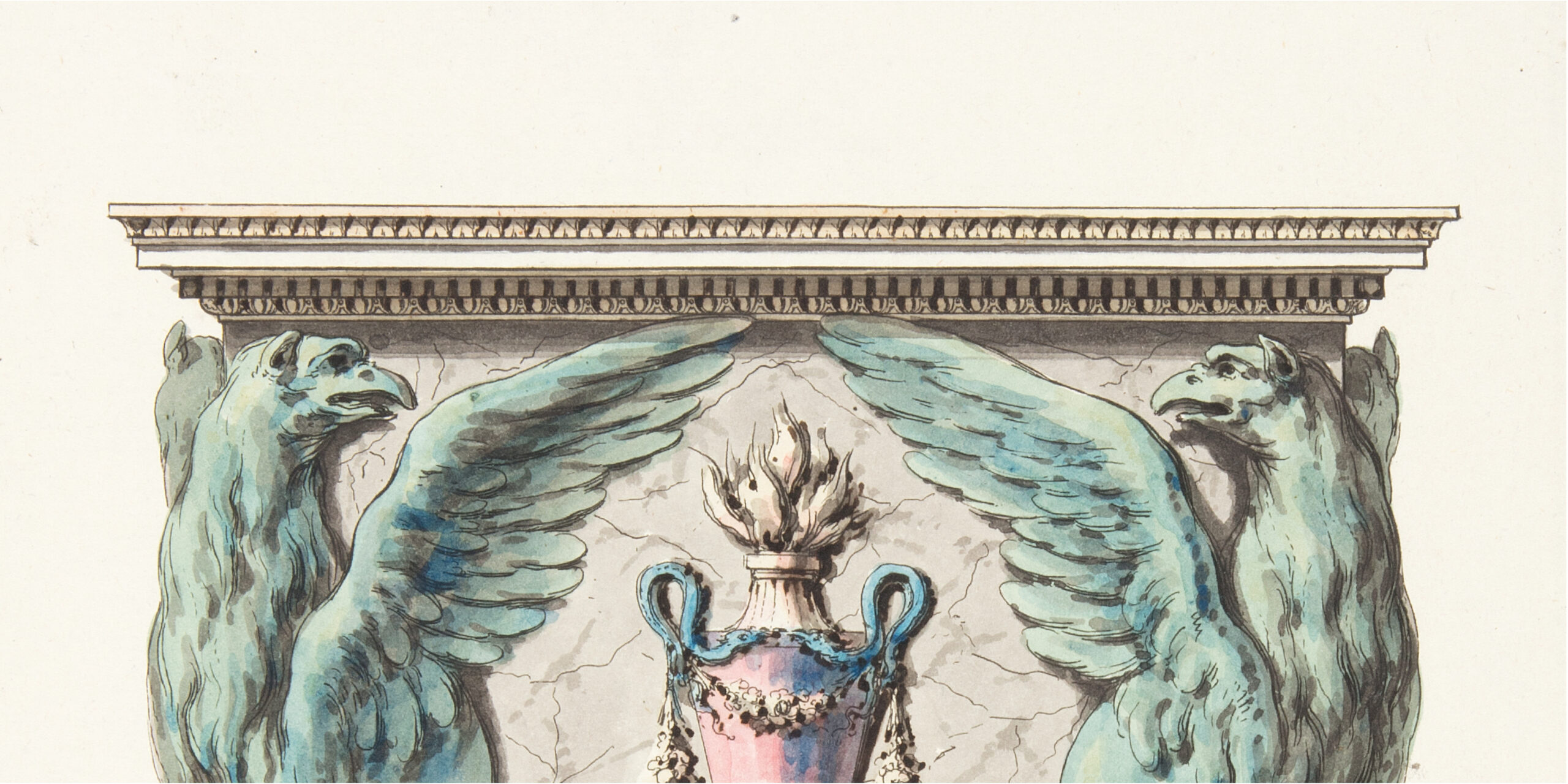DESIGNS FOR STOVES IN ANTIQUE AND MODERN FORMS INVENTED AND PRODUCED BY OLLIVIER’S MANUFACTORY FROM THE DECLOUX COLLECTION
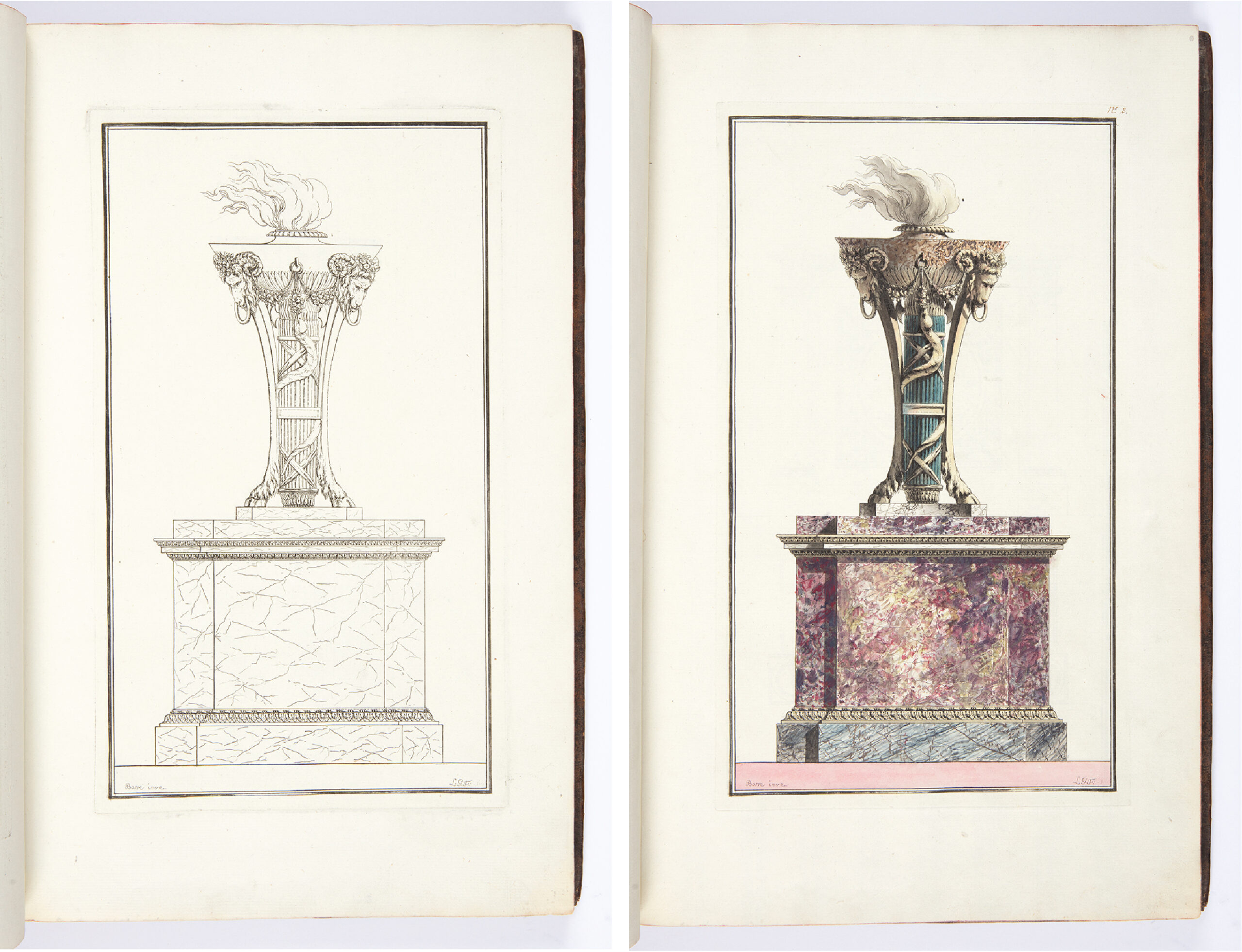
Fig. 1 & Fig. 2 – Bound Plates, PIED-D’ESTAL surmonté d’un trépied dans le genre antique, ou de tel autre ornement qu’on desirera (Pedestal Surmounted by a Tripod in the Antique Style, or Other Such Ornament as Desired ), plate 2 and 3 from COLLECTION DE DESSINS Des Poëles de formes antique et modern, ca. 1791; Louis-Gustave Taraval (French, 1738–1794), after Bosse (active ca. 1767–1794); Published by Louis François Ollivier (Paris, France); Etching on paper and etching and hand colored watercolor on paper; dimensions; Purchased for the Museum by the Advisory Council, 1921-6-407-3, -4
Within the hundreds of albums of ornament and architecture prints in the Decloux Collection, there is a curious and luxurious sales catalog for ceramic stove heaters. The album begins with a helpful introduction and explanation followed by 18 designs, each one printed twice: once with simple engraved lines and another richly hand colored with vivid pinks, greens, yellows, blues, and purples (Fig. 1). The text explains that the uncolored plates offer the possibility for future customers to customize their own designs. The catalog offers a sample of what the manufactory can produce and a source of inspiration for adapting and creating new designs.
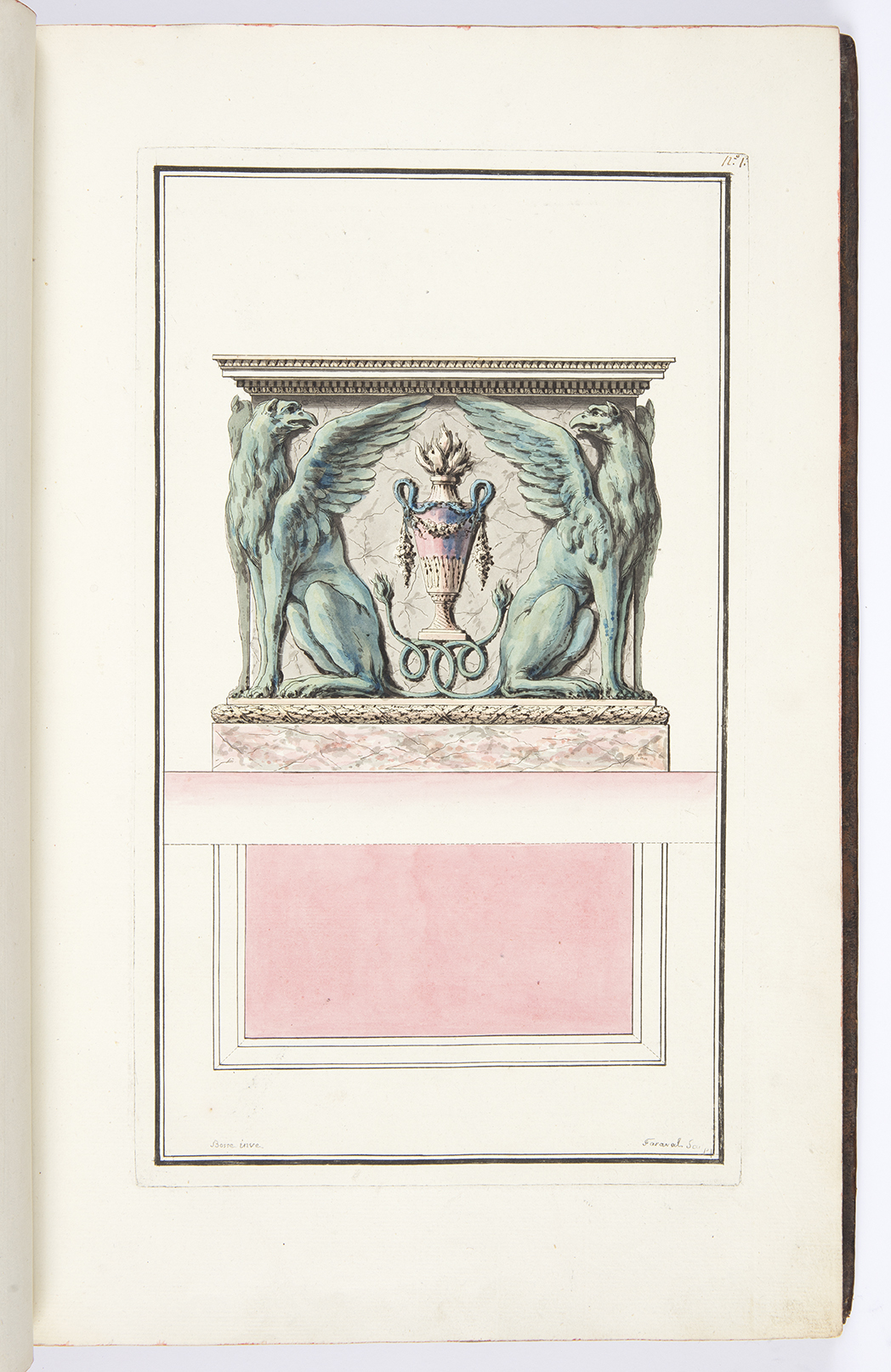
Fig. 3 – Bound Plate, POELE dans le genre antique, avec quatre griffons aux quatre angles, propre à être isolé (Stove in the Antique Style, with Four Griffins at the Four Corners), plate 1 from COLLECTION DE DESSINS Des Poëles de formes antique et modern, ca. 1791; Louis-Gustave Taraval (French, 1738–1794), after Bosse (active ca. 1767–1794); Published by Louis François Ollivier (Paris, France); Etching and hand colored watercolor on paper; 41.5 × 26.1 cm (16 5/16 × 10 1/4 in.); Purchased for the Museum by the Advisory Council, 1921-6-407-2
This catalog was produced by the Ollivier faience and porcelain manufactory in Paris at 73 rue de la Roquette[i] (now nos. 43/45). The term faience refers to the French production of tin-glazed earthenware pottery.[ii] Louis François Ollivier (1752–1810) took over the manufactory in 1777 from his mother Marie-Anne Genest (dates unknown) and her second husband Jacques Souroux (d.1782). Louis Francois’s father, Claude Ollivier (1728–1767), had inherited the manufactory from his father-in-law François Genest (ca. 1706–1765) in 1764. In 1777, when Louis François took over the manufactory, it was a successful business described as having a portico entrance, a hanger, four kilns, two stores, and three floors of workshops. Louis François Olliver expanded the business in 1782 by renting a house and some land on the rue Saint-Pierre and, in 1790, he employed 90 workers.[iii]
But times were changing in France; war, a financial crisis, and the ideas of the Enlightenment thinkers all contributed to the start of the French Revolution in 1789. This political upheaval and uncertainty had an enormous impact on everyday life, including commerce. Ollivier proved to be an intelligent businessman and inventor, adapting quickly to the new and ever-changing government administration, bureaucracy, technologies, and changing market of the French Revolution.
Adapting Business to a Revolution
On January 7, 1791, the new government passed the first-ever law in France allowing people to patent their inventions and discoveries for a period of five to fifteen years.[iv] This new law offered businesses a certain security, whereby their ideas and creations were now recognized as a form of protected property.[v] Ollivier seized this new opportunity and submitted a patent request on June 9, 1791, for eight earthenware techniques, including imitation marble, antique bronze, and ceramic cameos in the English manner, as well as stove heaters in faience imitating porcelain. He received a final approval from Louis XVI on November 16, 1791.[vi] Ollivier is the first French ceramic manufactory to apply for these patents under this new Revolutionary law.[vii] Ollivier’s development of techniques imitating British ceramics is proof of the changing fashion of the time, which was in part due to a 1786 commercial treaty between France and Britain allowing British imports of ceramics into France. English creamware was both superior in quality and cheaper than French faience. Ollivier was therefore trying to compete with this new foreign influx, as well as the rising prestige and availability of French porcelain.

Fig. 4 – Faience Stove Heater in the form of the Bastille, 1792; Louis François Ollivier (French, 1752–1810); Paris, France; H: 90 cm (3 7/16 in.); Sèvres; Cité de la céramique on loan to the musée Carnavalet, Paris; Courtesy of Shadowgate, licensed under CC 2.0 (slight cropping)
Just a year after receiving his patent, Ollivier presented one of his stove heaters to the National Convention, the first French Republican government formed in 1792 after the abolition of the monarchy, possibly trying to secure favor in case of further changes in bureaucracy. The stove—now in the Musée Carnavalet in Paris (Fig. 4)—is in the form of the Bastille prison, which became a key symbol of the Revolution after it was stormed on July 14, 1789.
Ollivier’s Stoves
The Ollivier manufactory specialized in wonderfully ornate and technologically advanced stove heaters, known as poêles in French. Ollivier’s catalog of stove designs, Collection of Designs for Stoves in Antique and Modern Forms (Fig. 5 & 6), was most likely produced around the time of his patent request in 1791 because many of the designs relate directly to the techniques listed, including examples of the imitation marble, bronze, cameos, and of course the production of faience stoves in imitation porcelain.
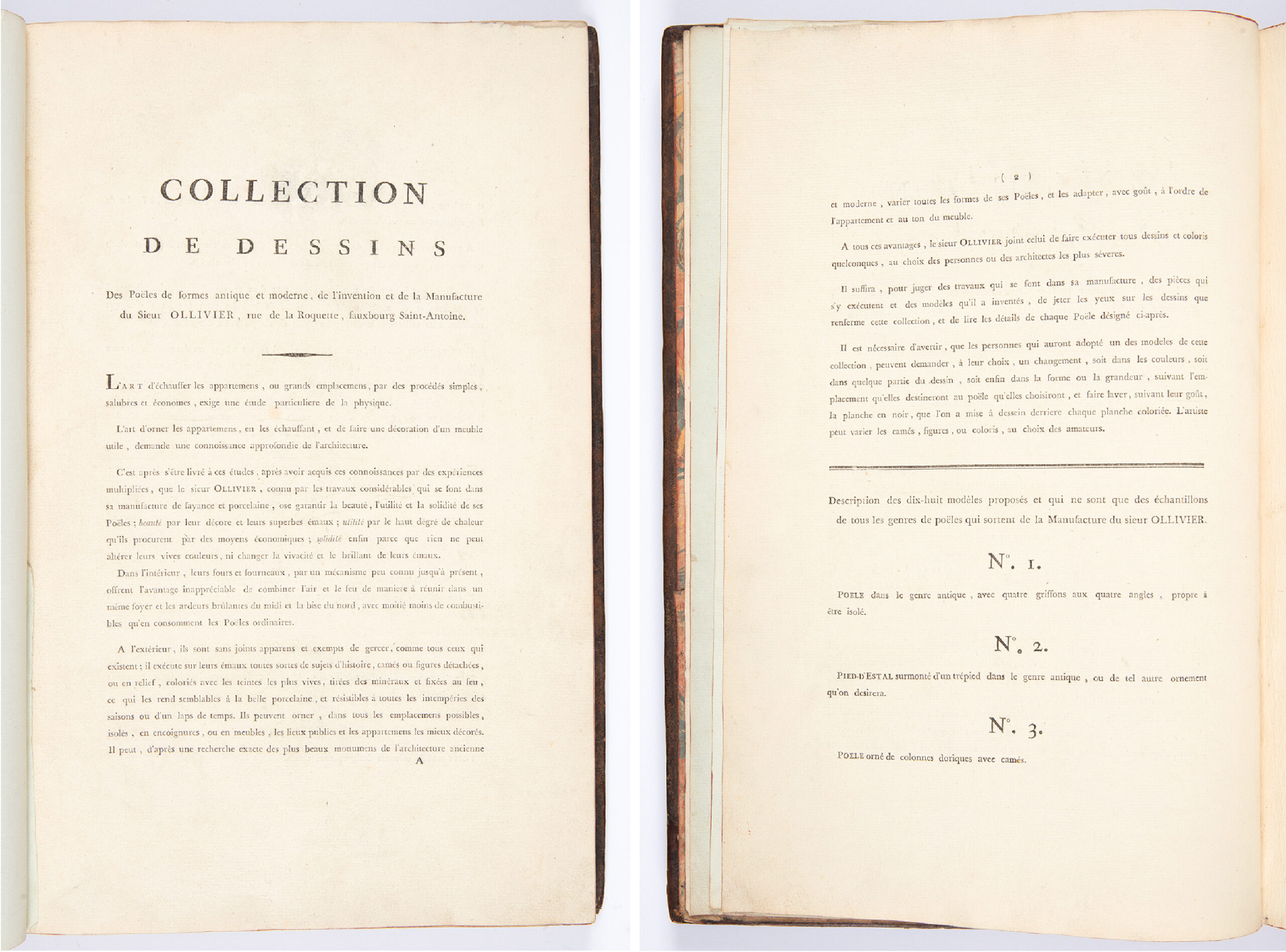
Fig. 5 & Fig. 6 – Book, COLLECTION DE DESSINS Des Poëles de formes antique et modern, de l’invention et de la Manufacture du Sieur OLLIVIER, rue de la Roquette, fauxbourg Saint-Antoine, pages 1 and 2, ca.1791; Louis François Ollivier (French, 1752–1810); Paris, France; Letterpress on paper; 41.5 × 26.1 cm (16 5/16 × 10 1/4 in.); Purchased for the Museum by the Advisory Council, 1921-6-407
The introduction included at the start of the catalog describes how these stoves are the result of many years of studies and the knowledge and experience gained by Olliver. It assures that the stoves are guaranteed to be beautiful, useful, economic in their heating technology, and resilient in their construction, promising that nothing could alter the colors and decoration. Ceramic stove heaters were popular in Europe throughout the 18th century, becoming highly decorative with ornamental features that made them aesthetically pleasing pieces of furniture in harmony with the decorative schemes of 18th-century interiors. Elsewhere in the Decloux collection, there are a few examples of stoves decorated in earlier rococo[viii] and [ix] motifs by the architect François de Cuvilliés (1695–1768) (Fig. 7).
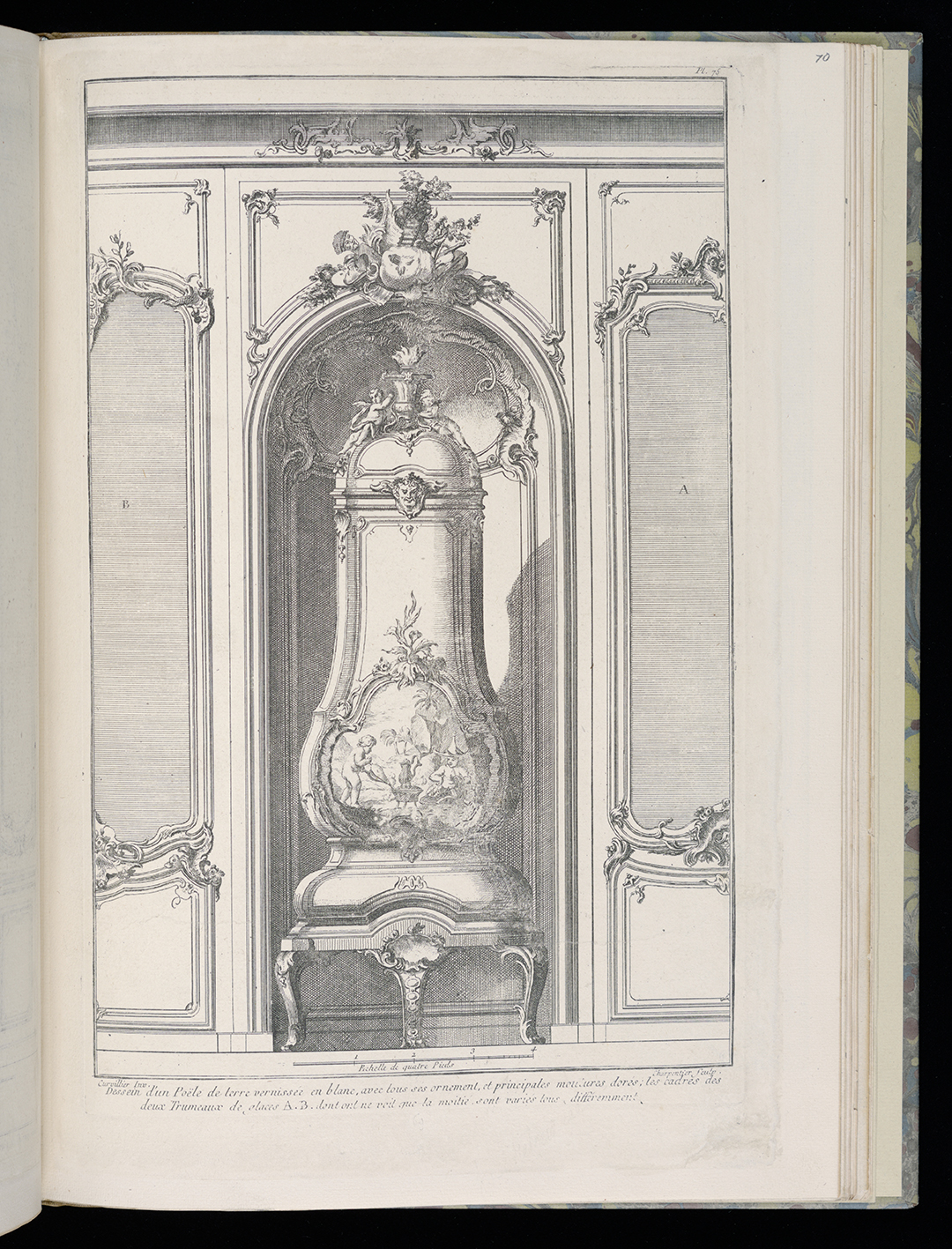
Fig. 7 – Bound Plate, Dessein d’un Poële de terre vernissée en blanc, avec tous ses ornement, et principales moulures dorés (Design for a white glazed earthenware stove, with all its ornaments and gilded moldings), plate 75, 1757; Etienne Charpentier (1707–1792), after François de Cuvilliés (1695–1768); Etching and engraving on paper; 41.5 × 26.1 cm (16 5/16 × 10 1/4 in.); Purchased for the Museum by the Advisory Council, 1921-6-282-71
The plates in the catalog are signed by a little-known artist named Bosse (possibly Louis Bosse, active ca. 1770) and engraved by the architect and printmaker Louis-Gustave Taraval (1738–1794). The designs feature neoclassical motifs, which became popular in the mid-to-late 18th century, including columns, portrait busts, friezes, creamware-style cameos, mythological creatures and goddesses, and military emblems, glazed with vivid colors imitating marble and other noble materials (Fig. 8, 9 & 10). The colored plates cleverly use shadows to illustrate the profile views and three-dimensionality of the shapes, especially for those set within niches. Other designs that take the form of plinths or pedestals and that are meant to be against a wall or in a corner are engraved with a view from the front and from above to illustrate their shapes. Some are also engraved with a scale along the bottom.
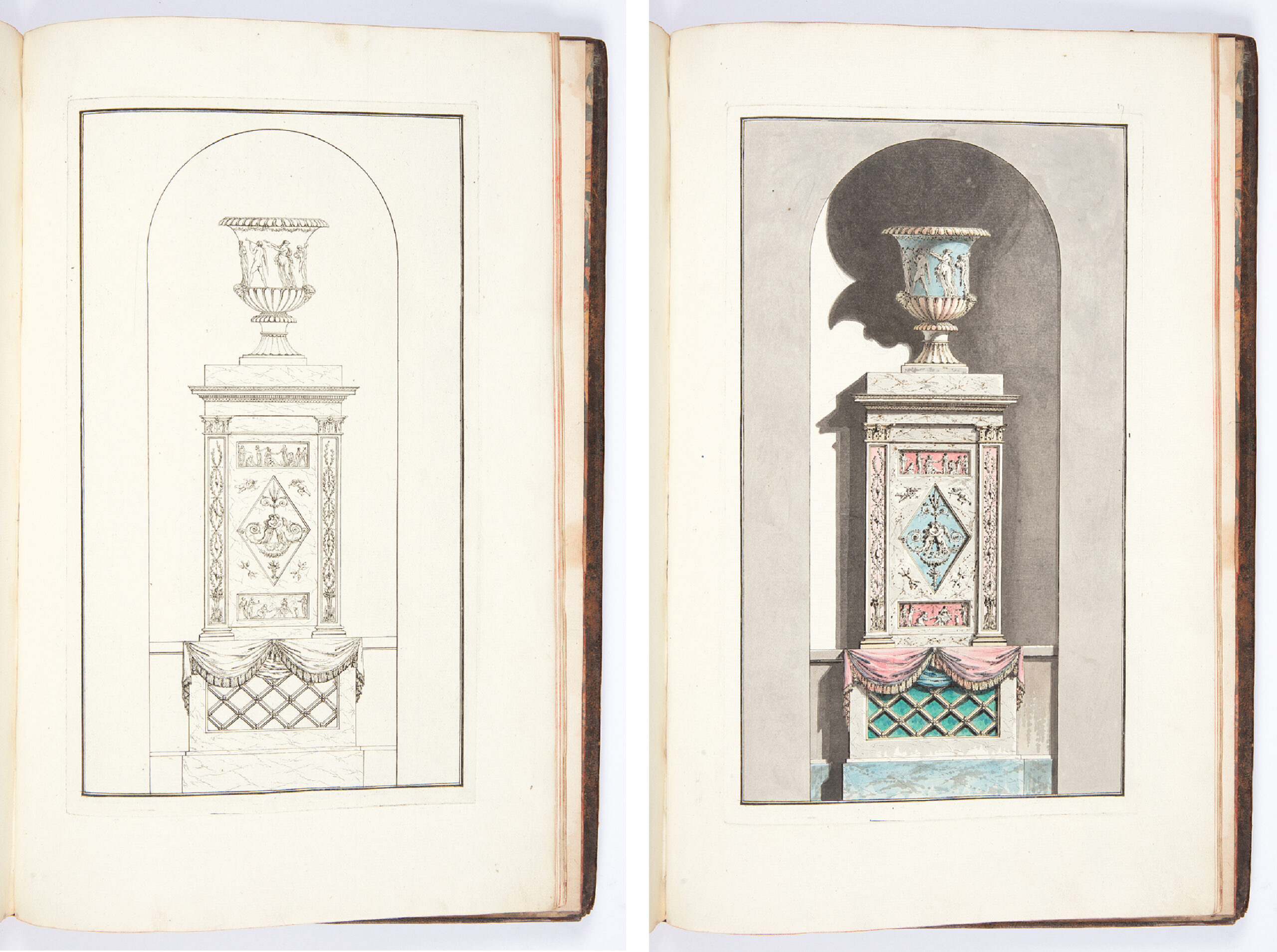
Fig. 8 & Fig. 9 – Bound Plate, POELE Russe avec pilastres d’ordre composé, orné de camés et draperies (Russian Stove with Pilasters of the Composite Order, Decorated with Cameos and Draperies), plates 17 and 18, from COLLECTION DE DESSINS Des Poëles de formes antique et modern, ca. 1791; Louis-Gustave Taraval (French, 1738–1794), after Bosse (active ca. 1767–1794); Published by Louis François Ollivier (French, 1752–1810); Paris, France; Etching on paper and etching and hand colored watercolor on paper; 41.5 × 26.1 cm (16 5/16 × 10 1/4 in.); Purchased for the Museum by the Advisory Council, 1921-6-407-33, -34
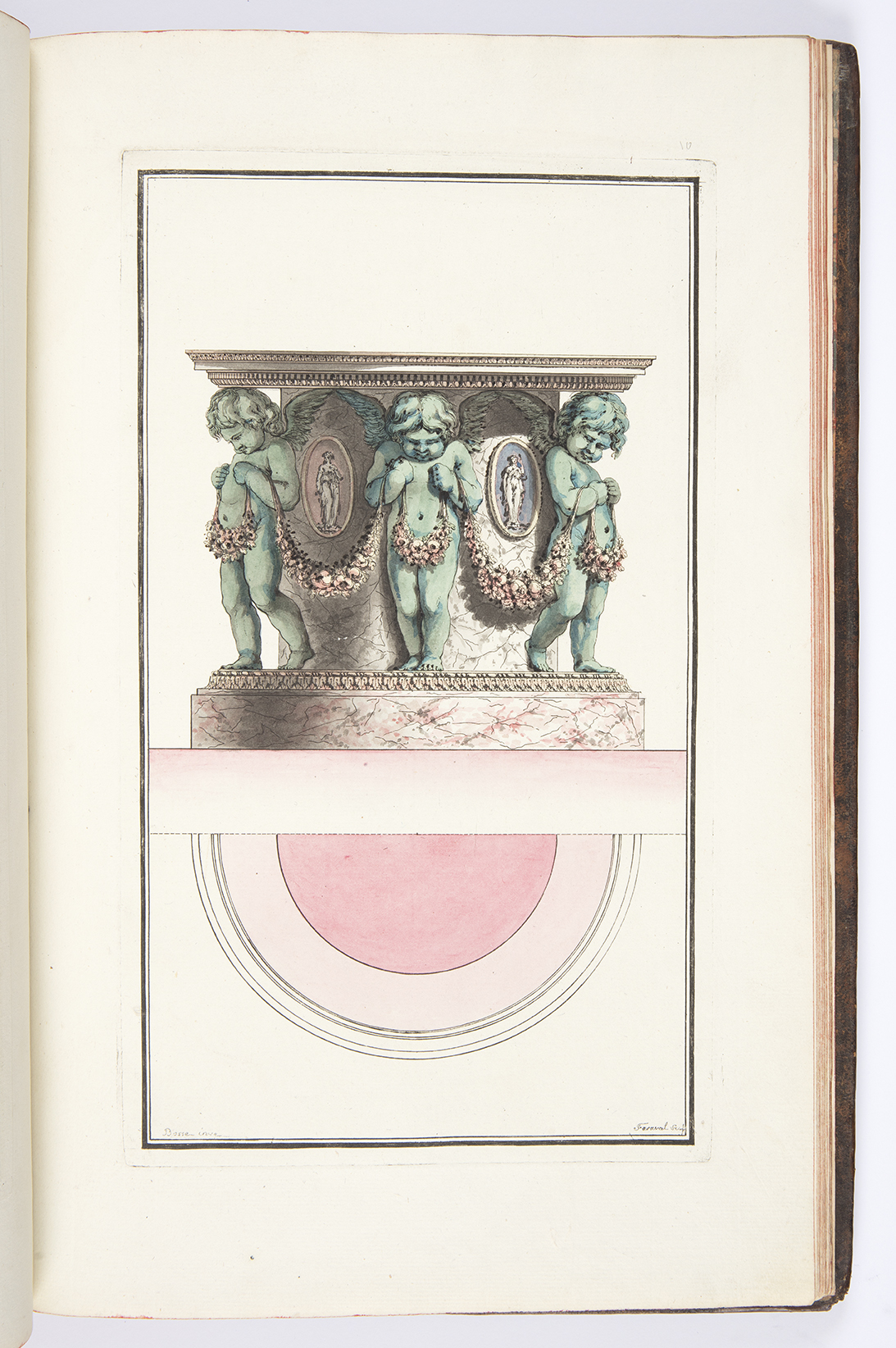
Fig. 10 – Bound Plate, POELE circulaire, dans le genre antique, sans tuyaux montans ni apparens, et fait pour être isolé (Circular Stove, in the Antique Style, Without Rising nor Visible Pipes, to be Insulated), plate 10, from COLLECTION DE DESSINS Des Poëles de formes antique et modern, ca. 1791; Louis-Gustave Taraval (French, 1738–1794), after Bosse (active ca. 1767–1794); Published by Louis François Ollivier (French, 1752–1810); Paris, France; Etching and hand colored watercolor on paper; 41.5 × 26.1 cm (16 5/16 × 10 1/4 in.); Purchased for the Museum by the Advisory Council, 1921-6-407-20
The stove designs are elegant and creative, with some playful elements such as a stove imitating palm trees in a planter to be used inside an orangery (a conservatory for orange and other fruit trees), a trompe l’oeil effect made to camouflage the heater within the surrounding real plants and trees (Fig. 11). The technology used to pump the heat up the two trees is also used in this wonderful mantel design for another stove heater, complete with an overmantel mirror and a mantel clock, replacing the traditional fireplace with the new heating technology of the stove while maintaining the design qualities of the old mantlepiece (Fig. 12).
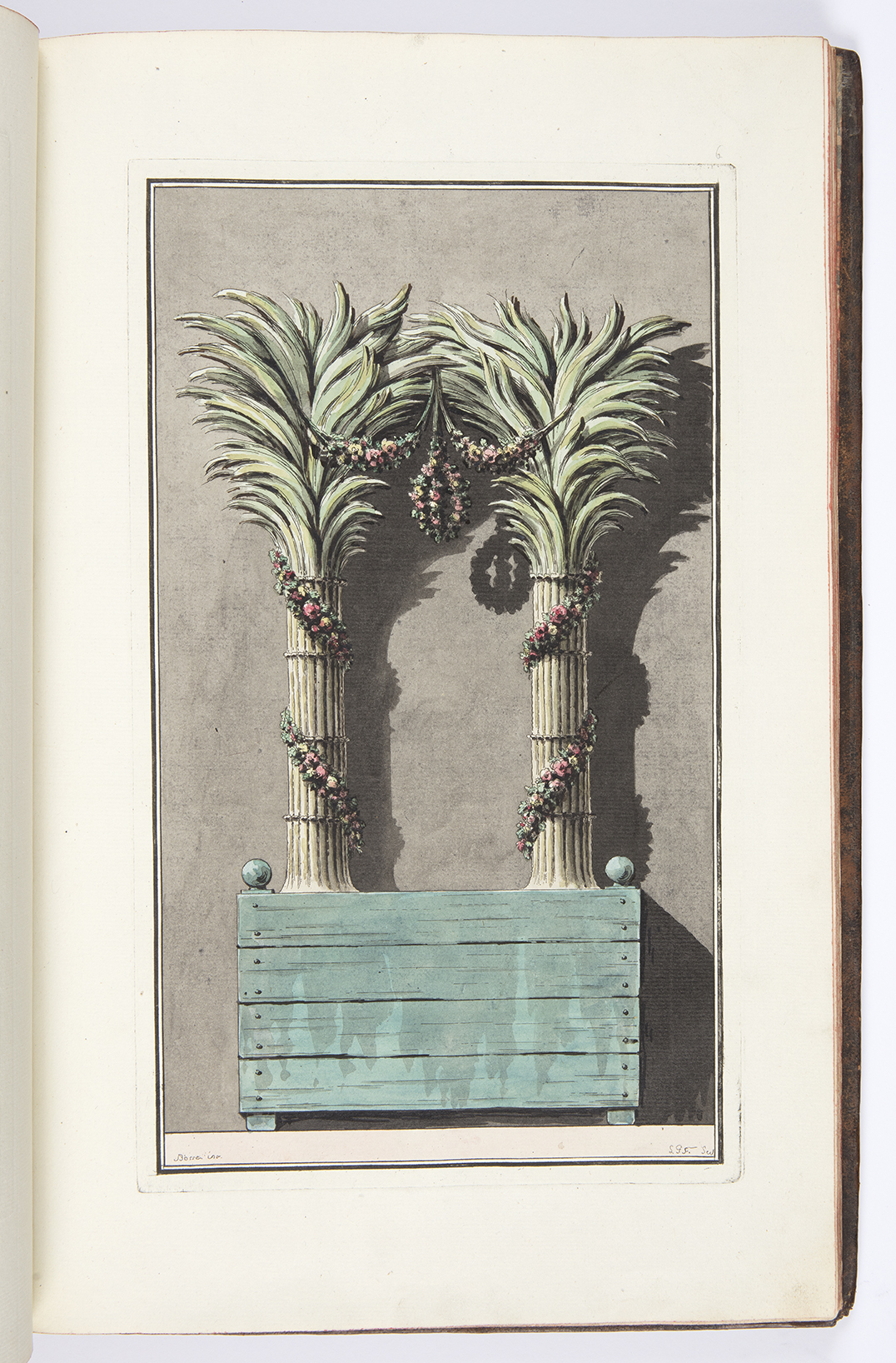
Fig. 11 – Bound Plate, POELE d’un genre absolument nouveau, propre à être place dans une orangerie, superbe serre chaude, ou dans un appartement d’été en hyver, réunissant l’avantage de multiplier les tuyaux à la chaleur qui monte à droite, passe au milieu des têtes des deux palmiers, descend à gauche, et par son circuit, augmente considérablement les émanations ignées, sans augmenter la consummation du combustible (Stove of a New Kind, Fit for an Orangery, or for a Summer Apartment in the Winter, Combining the Advantage of Multiplying the Heating Pipes That Rise to the Right, and in the Middle of the Heads of the Two Palm Trees, Descending to the Left, and by its Circuit, Increases the Emanations Without Increasing the Consumption of Fuel), plate 6, from COLLECTION DE DESSINS Des Poëles de formes antique et modern, ca. 1791; Louis-Gustave Taraval (French, 1738–1794), after Bosse (active ca. 1767–1794); Published by Louis François Ollivier (French, 1752–1810 ); Paris, France; Etching and hand colored watercolor on paper; 41.5 × 26.1 cm (16 5/16 × 10 1/4 in.); Purchased for the Museum by the Advisory Council, 1921-6-407-12
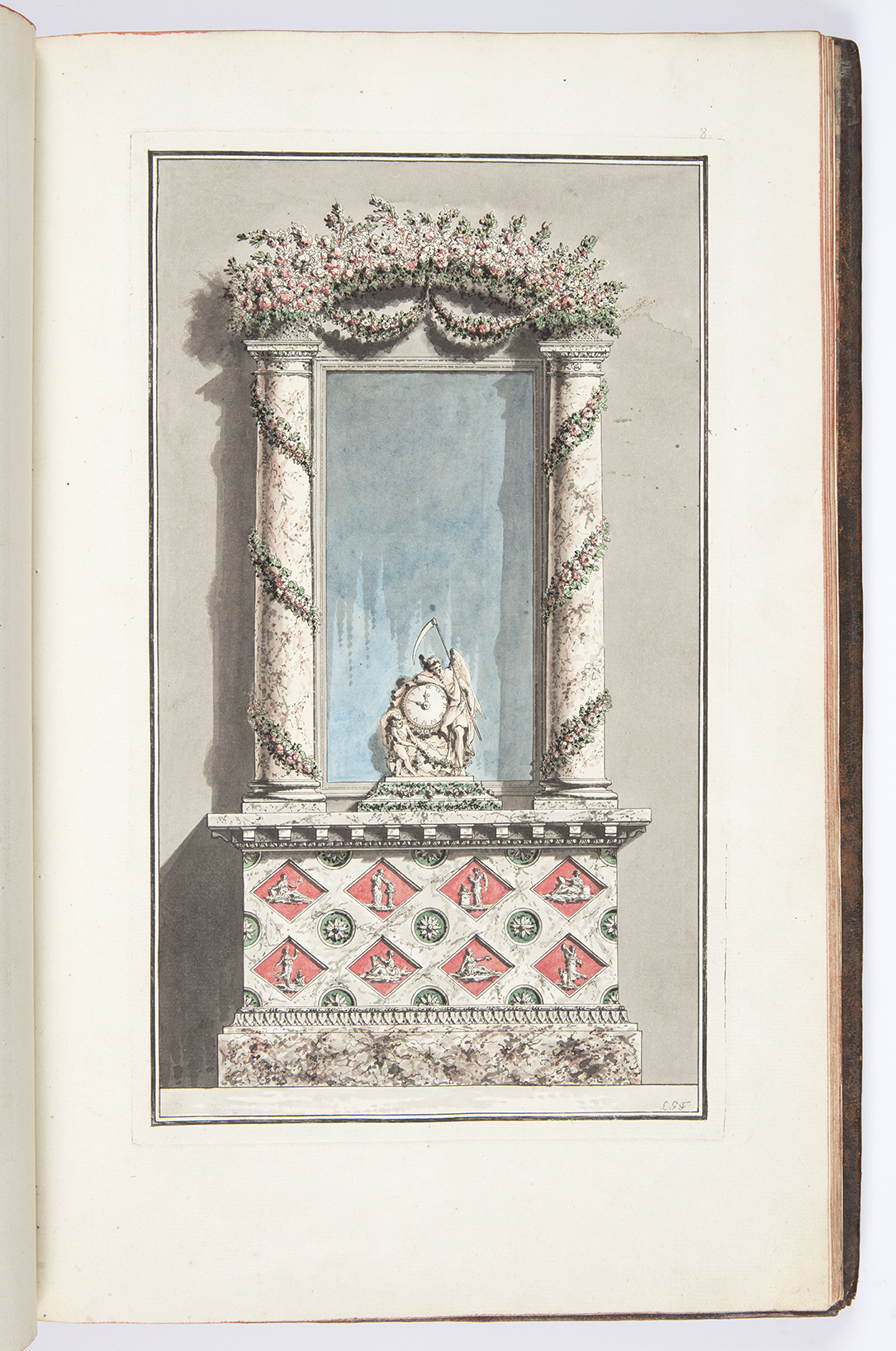
Fig. 12 – Bound Plate, Superbe POELE formant meuble et décore, multipliant les tuyaux de chaleur par le même proceed que celui du No. 6; pouvant s’ajuster devant une glace; que l’on peut renvoyer par un bouton, dans une boiserie à coulisse, et qui peut découvrir une croisée, dont la situation offre une belle vue. Il est impossible de décrire tous les changemens et avantages dont ce Poële est susceptible. (Superb Stove in the Form of a Piece of Furniture and Decorated, Multiplying the Heat Pipes by the Same Process as that of No. 6; Can be Adjusted in Front of a Mirror; With a Button Within a Sliding Pane, Which Can Offer a Beautiful View. It is Impossible to Describe all the Changes and Advantages Which this Stove can Offer.), plate 9, from COLLECTION DE DESSINS Des Poëles de formes antique et modern, ca. 1791; Louis-Gustave Taraval (French, 1738–1794), after Bosse (active ca. 1767–1794); Published by Louis François Ollivier (French, 1752–1810 ); Paris, France; Etching and hand colored watercolor on paper; 41.5 × 26.1 cm (16 5/16 × 10 1/4 in.); Purchased for the Museum by the Advisory Council, 1921-6-407-16
We do not know how many of these catalogs were printed at the time, but they are quite rare in public collections. Other known copies are in the collections of the Metropolitan Museum of Art[x], Sir John Soane’s Museum London[xi], the Victoria & Albert Museum (incomplete)[xii], Bibliothèque de l’Institut National d’Histoire de L’Art[xiii], and Bibliothèque Municipale de Besançon[xiv]. Copies are also mentioned in the major ornament print reference books.[xv] Comparing the digitized copies is fascinating because of the variety in hand-coloring, with completely different color schemes from copy to copy. Ollivier may have wanted each copy to vary to further highlight his flexibility and his wide range of offerings, as he describes in the printed introduction. Interestingly, the INHA copy is bound in an almost identical binding to the Cooper Hewitt copy, possibly suggesting that these luxurious catalogs were bound by Ollivier and were given as presentation copies to promote his manufactory (often during this period, prints and books were purchased unbound or in paper wrappers). The bindings are good quality leather (calf or sheepskin); the covers are decorated with a mottled effect and blind triple ruled borders with some gold tooling along the spine; and marbled paper pastedowns and endpapers. The Soane copy is not digitized, but the online collection catalog describes a similar binding.
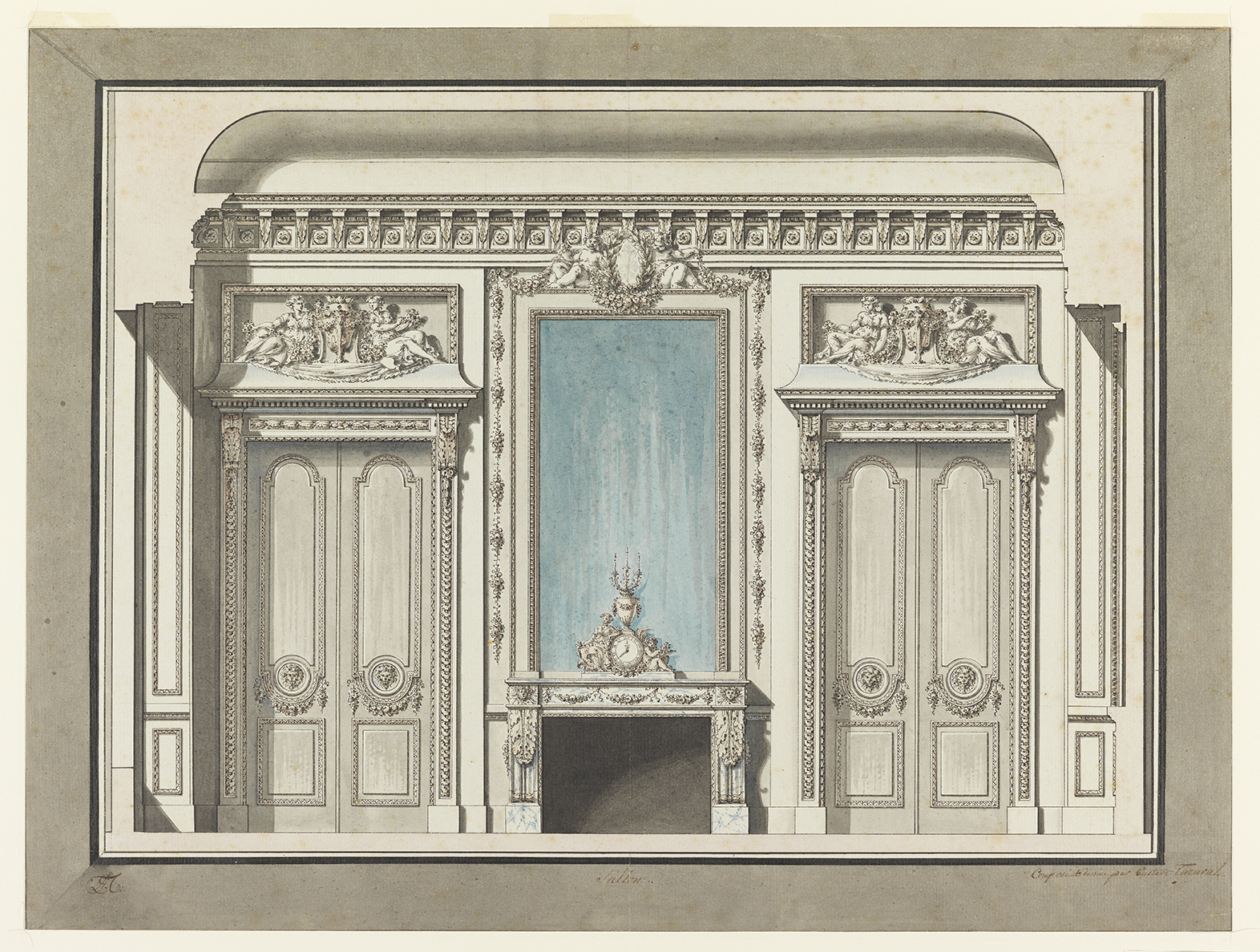
Fig. 13 – Drawing, Wall Elevation for a Salon with Mantelpiece, ca. 1785; Louis-Gustave Taraval (French, 1738–1794); Pen and black ink, brush, and rose and blue watercolor on paper; 43 × 67.5 cm (16 15/16 × 26 9/16 in.); Purchased for the Museum by the Advisory Council, 1911-28-280
Although not much is known of the designer Bosse, the printmaker Louis-Gustave Taraval is better known as an architect and designer. The Decloux collection has several drawings by Taraval of his own designs and a series of architectural prints (Fig. 13, 14). This series of stove designs would have been produced in the last years of his life, and, given his experience, he may have had more input in the designs than the mere signatures suggest.[xvi]
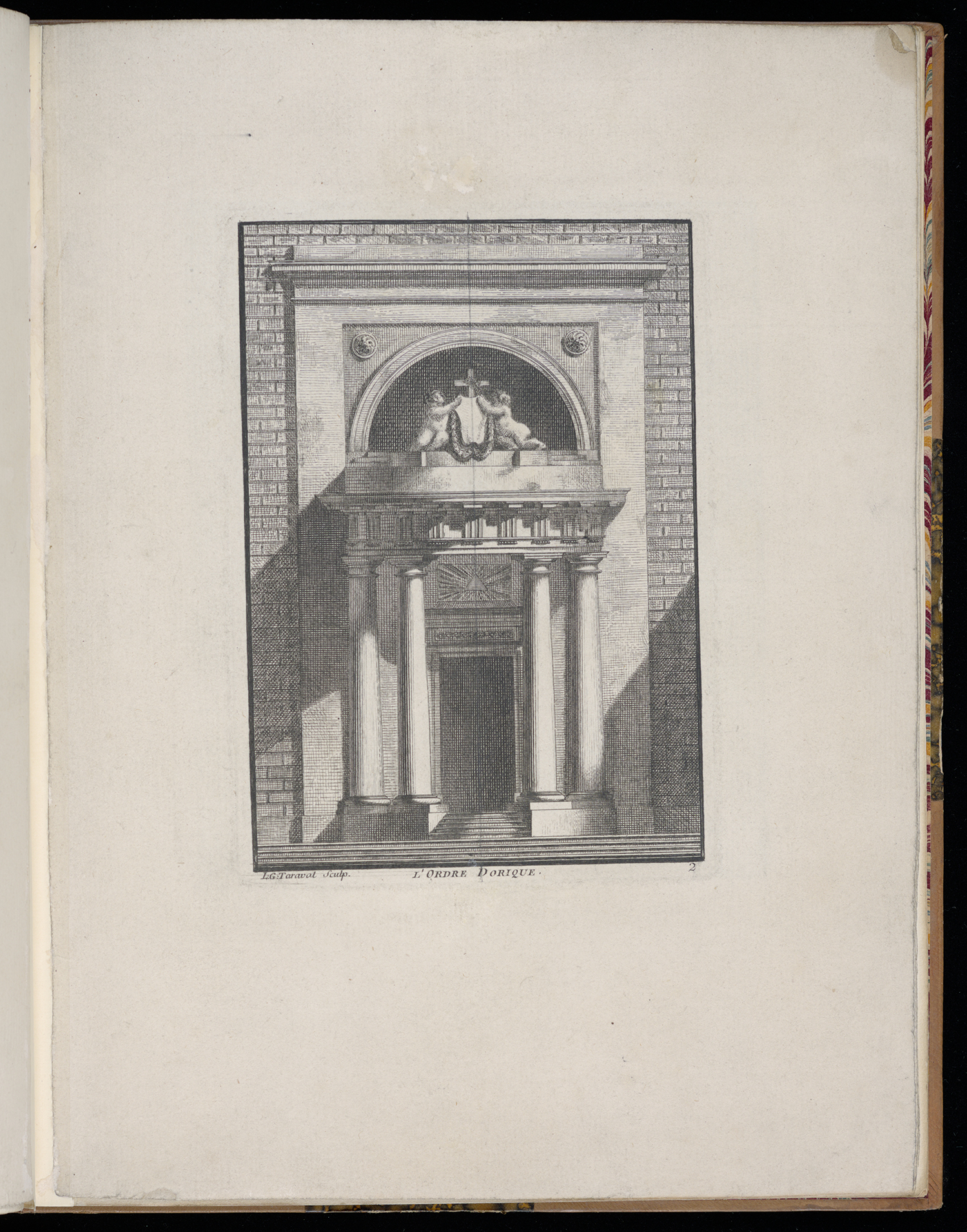
Fig. 14 – Bound Plate, L’ORDRE DORIQUE (The Doric Order), plate 2, from PLUSIEURS PORTAILS ET PORTES, 1768–75; Louis-Gustave Taraval (French, 1738–1794); Published by Jacques-François Chéreau (French, 1742–1794); Paris, France; Etching on paper; 28.5 × 21.2 cm (11 1/4 × 8 3/8 in.); Purchased for the Museum by the Advisory Council, 1921-6-485-2
This curious and colorful catalog of stove designs is not only a beautiful example of late 18th-century printmaking, innovation, and technology, but also an intelligent marketing strategy by a creative businessman trying to adapt to the rapidly changing world of the French Revolution.
Rachel Jacobs, Remote Senior Research Cataloger, Drawings, Prints & Graphic Design
Notes
[i] Almanach du commerce et de toutes les addresses de la ville de Paris, pour l’an VII (Paris: Chez Favre; et B. Duchesne, 1798), 145.
[ii] For more information, see “French Faience,” The Metropolitan Museum of Art, https://www.metmuseum.org/toah/hd/ffai/hd_ffai.htm.
[iii] Régine de Plinval de Guillebon, “Une manufacture de faïence à Paris. De François Genest à Louis François Ollivier (1734–1808),” in Sèvres. Revue de la Société des Amis du musée national de Céramique, No. 27 (2018): 44–63, https://www.persee.fr/doc/sevre_1169-2537_2018_num_27_1_1168.
[iv] Description des Machines et Procedes specifies dans les brevets d’invention, de perfectionnement et d’importation dont la duree est expiree, Publié d’apres les ordres de M. Le Comte Montalivet, Minitstre de l’interieur, Par C. P. Moland, Administrateur du Conservatoire des Arts et Metiers (Paris: L’imprimerie de Madale Huzard, Nee Vallat La Chapelle, 1811), 132.
[v] For more detailed information, see Gabriel Galvez-Behar, “L’État et le brevet d’invention: une relation embarrassée, 1791–1902,” in Concurrence et marchés, edited by Patrick Fridenson, François Monnier, and Albert Rigaudière (Vincennes: Institut de la gestion publique et du développement économique, 2023), https://doi.org/10.4000/books.igpde.16918.
[vi] The patents and the explanations to produce each invention were later published and made public in 1811, after the duration of the 15-year patent. See, Description des Machines et Procedes specifies dans les brevets d’invention, de perfectionnement et d’importation dont la duree est expiree, Publié d’apres les ordres de M. Le Comte Montalivet, Minitstre de l’interieur, Par C. P. Moland, Administrateur du Conservatoire des Arts et Metiers (Paris: L’imprimerie de Madale Huzard, Nee Vallat La Chapelle, 1811).
[vii] Plinval de Guillebon, “Une manufacture de faïence à Paris. De François Genest à Louis François Ollivier (1734–1808),” 62.
[viii] Rococo developed as an artistic style in early 18th-century France and spread throughout Europe, the name derived from rocaille, the French word for rock or shells. The style is associated with asymmetric forms and motifs derived from nature.
[ix] Derived from Chinois, the French word for “Chinese,” chinoiserie describes a European style of ornament associated with rococo, inspired by Chinese, Japanese, and other Asian artistic traditions, which reached its height in popularity in the middle of the 18th century.
[x] From the Metropolitan Museum of Art, accession number 67.725.2, https://www.metmuseum.org/art/collection/search/354853 (accessed June 4, 2024).
[xi] From Sir John Soane’s Museum Collection Online, accession number 2912, https://collections.soane.org/b8225 (accessed June 4, 2024).
[xii] From the Victoria and Albert Museum, accession number E.484-1991, https://collections.vam.ac.uk/item/O193935/collection-de-dessins-des-po%C3%ABles-print-bosse/ (accessed June 4, 2024).
[xiii] From the Institut national d’histoire de l’art, NUM FOL RES 92, https://bibliotheque-numerique.inha.fr/collection/item/19798-collection-de-dessins-des-poeles-de-formes-antique-et-moderne?offset=9740 (accessed June 4, 2024).
[xiv] From the Bibliothèque Municipale de Besançon, No. 16378, https://memoirevive.besancon.fr/ark:/48565/g5q7m4kvpc10 (accessed June 4, 2024).
[xv] The standard catalogs of ornament prints are D. Guilmard, Les Maîtres Ornemanistes (Paris, 1880–81), https://gallica.bnf.fr/ark:/12148/bpt6k6122798r, and the Katalog der Ornamentstitchsammlung der Staatlichen Kunstbibliothek Berlin (Berlin, 1939), https://archive.org/details/katalogderorname00staa.
[xvi] The plates are signed “Bosse inv. and Taraval Sculp.” “Inv” refers to invenit, meaning “designed by,” and “sculp” refers to sculpsit or sculpebat, meaning “engraved.”
